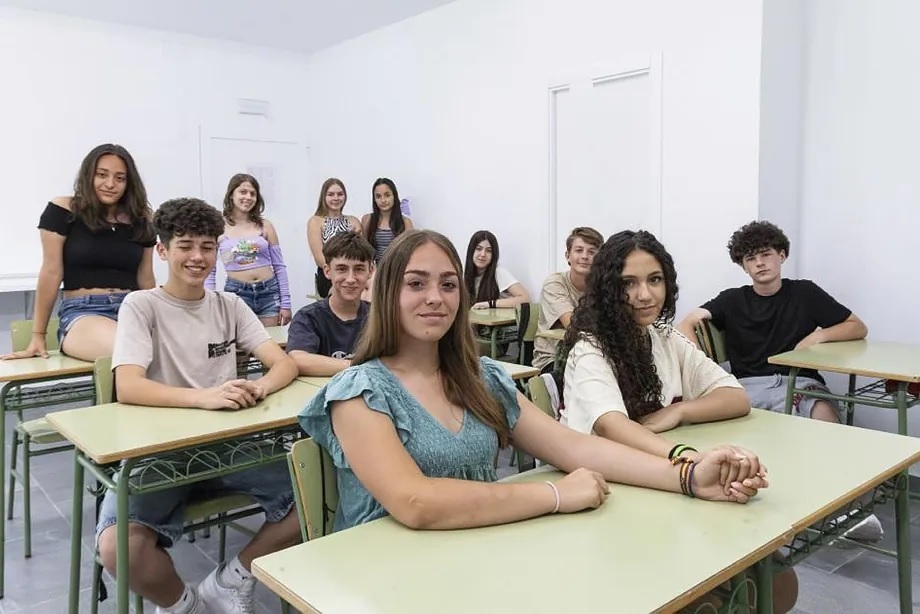The saying goes that adversity brings out the worst in some people and the best in others. An example of this is the heroic feat carried out by 13 students, aged between 14 and 16, from IES Humanejos school (Parla, Madrid) during their language immersion trip in Ireland.
From May 11 to the early hours of May 17, they were in the small coastal town of Bray, 40 minutes from Dublin, improving their English skills by staying in native homes.
However, their true experience didn't begin until Friday, May 16. That afternoon, the last day of the trip, the group of students had free time: some went to watch a soccer match, others went for a walk... and 13 of them decided to buy burritos and go to the beach to eat them on the sand.
Everything was fine until one of them noticed a woman, whom they had seen entering the sea a while ago, floating on her back, with her head submerged in the water, about 20 meters from the shore.
"At first, we thought she was snorkeling, but after several minutes we started to get nervous. We didn't know what to do, we argued a bit... Until I decided to jump into the sea with Ainhoa and Sofia," says Ángela, who also suffers from thalassophobia (fear of large bodies of water): "Since I can't see what's underneath, it has always made me uneasy. I never go further than my knees at the beach. But at that moment, I jumped without thinking."
Álvaro, Gabriela, and Samara, seeing that their classmates couldn't carry the woman, who "weighed quite a few kilos", also entered the sea to help. They managed to turn the body around, and the drowning woman "started foaming at the mouth." This scared some of them, who let go of her as a reflex action.
"We moved away, due to the shock, and unintentionally she fell on top of Ainhoa, who was holding her by the armpits and whose arms were around the woman's back," Ángela explains. And Ainhoa continues: "I was underwater, with my head submerged... Álvaro managed to lift her a bit so I could resurface."
With considerable effort, as that body "was quite slippery," they managed to bring it to solid ground. Although, they thought "she was already dead" the whole time. On the beach, dozens of adults were starting to gather, motionless, watching the scene. "No one came to help us... They just recorded us with their phones. Some even, while we were debating whether to go in or not, told us that if she died, it would be our fault...," recalls Ainhoa, who, after reaching the shore, tried to stand up but quickly felt her knee dislocate. At the same time, the strong blow to her ribs started to take effect, making it difficult for her to breathe. "When the adrenaline wore off, I felt down. My head started to hurt, I began to shiver... And I was short of breath."
At the same time, just a few meters away, a man had approached and started performing CPR on the drowning woman. Another classmate from IES Humanejos, Jimena, was helping him count the chest compressions. The affected woman never reacted.
Emergency services arrived promptly. Some paramedics took the recovering woman in an ambulance. Others began to attend to Ainhoa, who was also taken to a nearby children's hospital. "While I was being treated, they confirmed to me that the woman was alive, in intensive care. That reassured me," this student recounts.
Some teenagers in this group felt bad for not having had the courage to jump into the sea, perhaps blocked by the situation, but "everyone helped." "Those who stayed on the shore called Emergency services, the teachers... Others came to cover us with a towel because people wouldn't stop recording us, and we were in bikinis. That was very unpleasant," Ainhoa recalls.
"We are proud of what we did, but between the promenade and the beach, there could have been 400 people and no one did anything... We felt a bit of helplessness and anger because they wouldn't stop recording us," adds Álvaro, who is certain that, without their intervention and that of their classmates, that woman would be dead now: "No one would have gone in. And if they had, it would have been too late. The doctors themselves said that a few more minutes and...."
Local media in Bray picked up the story, but they reported it "very poorly." "They said that I alone saved two women with a rope... But none of that, there were 13 of us," smiles Ainhoa, who that day in Ireland ended up leaving the hospital shortly before two in the morning, being able to meet up with the rest of her classmates at 2:15 and head to the airport as the plane was leaving at 6:00.
Upon their return to Spain, congratulations poured in, recognizing their great intervention. And Ainhoa concludes: "Young people from Parla are often negatively labeled. We get a bad reputation... In fact, some were surprised that we helped. Some belong to gangs, yes, but most don't. Not all teenagers are lazy or only think of themselves."
